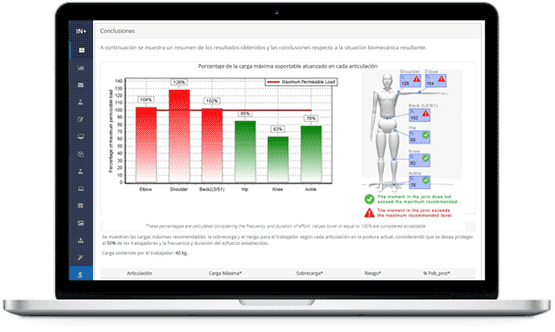

Repeated or continuous adoption of awkward postures during work can lead to fatigue and eventually result in musculoskeletal disorders. The static or postural load is a critical factor to consider when evaluating working conditions, and reducing it is essential for improving workstations.
Several methods have been developed to assess the risk related to postural load at a workstation, each with its distinct application scope and result contributions. RPA is not a method that identifies risk factors linked to postural load but serves as a preliminary tool for a rough assessment of a worker's postures throughout the day. If an EPR study indicates a high static load, the evaluator should conduct a more comprehensive study of the workstation using specific postural evaluation methods such as RULA, OWAS, or REBA.
The method calculates static load by considering the types of postures a worker adopts and the duration they maintain them, providing a numerical value proportionate to the load level. Based on the static load value, the method suggests an Action Level ranging from 1 to 5.
RPA utilizes the static load valuation system of the LEST method, developed by F. Guélaud, M.N. Beauchesne, J. Gautrat, and G. Roustang, members of the Laboratoire de Economie et Sociologie du Travail (L.E.S.T.), of the CNRS, in Aix-en-Provence.
RPA focuses on an overall assessment of various postures and the duration they are maintained, rather than evaluating specific postures. The method assumes that a worker can adopt 14 possible generic postures, as listed Table 1.
| Posture table | |||||
| Sitting normally |
 |
Sitting leaning forward |
 |
Sitting with arms above shoulders |
 |
| Standing normally |
 |
Standing with arms in front extension |
 |
Standing with arms above shoulders |
 |
| Standing leaning forward |
 |
Standing heavily leaning forward |
 |
Kneeling normally |
 |
| Kneeling leaning forward |
 |
Kneeling with arms above shoulders |
 |
Lying down with arms above shoulders |
 |
| Squatting normally |
 |
Squatting with arms above shoulders |
 |
The evaluation process starts with observing the worker for one hour while performing their tasks. During this time, the evaluator notes the different postures adopted (from Table 1) and the duration of each posture. If the work cycle is short and regular, the evaluator can measure the time each posture is adopted during a cycle and calculate the proportionate duration for one hour. For example, if an operator maintains the "Standing leaning forward" posture for 40 seconds in a 5-minute cycle, they will maintain that posture for 8 minutes in an hour of work.
Using this data, the method calculates the Postural Load value. The method then categorizes the final scores into action levels, which guide the evaluator in making decisions after the analysis. These action levels range from level 1, signifying that the evaluated postures are acceptable, to level 5, indicating that the static load is harmful to the worker and urgent measures must be taken to improve the workplace (Table 2).
| Score | Level | Action |
|---|---|---|
| 0, 1 or 2 | 1 | Satisfactory situation. |
| 3, 4 or 5 | 2 | Minor discomfort. Some improvements could provide more comfort to the worker. |
| 6 or 7 | 3 | Moderate discomfort. Risk of fatigue. |
| 8 or 9 | 4 | Severe discomfort. Fatigue. |
| 10 or more | 5 | Harmfulness. |
A cloud based software that integrates more than 20 tools for managing the ergonomics of the workstations in your company.
Evaluate all ergonomic risk factors of the workstations in your company: inadequate postures, repetitive movements, load handling, thermal environment...

Use Artificial Intelligence for the automated detection of postures in photographs or videos.
Generate fully customizable reports in Microsoft Word or Adobe Pdf format.
In a multiuser environment so that your company can have access to your data everywhere.
You only need a free account on Ergoniza
ERGONIZA allows you to use Artificial Intelligence for postural load assessment. Automatically capture workers’ postures from a photograph or a video and obtain an automated evaluation of the risk associated with inadequate or forced postures.
AI in actionERGONIZA helps you manage the ergonomics of the workstations of your companies. Evaluate all the risk factors present in the workstations, manage the evaluations, and obtain editable and customizable reports.
You only need to register as a user of ERGONIZA to start testing.
Sign UpUnlock the full potential of Ergoniza. By becoming a Pro User you'll have access to all of Ergoniza and be able to use all of the online software without restrictions or time limits. You'll be able to use the results of evaluation methods and tools in your professional activity. You'll be able to print the results reports in pdf or Word and save your studies in files to open them later.
To register as a Pro user, you must first login to Ergoniza.
(*) In European Union countries, the price will be increased with the corresponding VAT.
(**) The price in american dollars has been calculated at the current exchange rate and may vary.
is a web by . Ergonautas is the specialized website in occupational ergonomics and ergonomic assessment of workstations at the . Ergonautas aims to be a useful support tool for the Occupational Risk Prevention and Ergonomics professional and people in training, providing rigorous technical information on occupational ergonomics, online tools for its application, research, training, and participation forums.
Ergonautas is formed by a large human team. In addition to technicians and programmers, the Ergonautas team is made up of researchers and professors from the Polytechnic University of Valencia. The team, led by José Antonio Diego Más, is at the forefront of research and teaching in ergonomics, teaching in official degrees and master's degrees, and developing research projects in the field of ergonomics and new technologies oriented towards humans.
If you need to know more, get in touch with Ergonautas
Or follow us on Linkedin
- - -
© 2006 - Universidad Politécnica de Valencia




